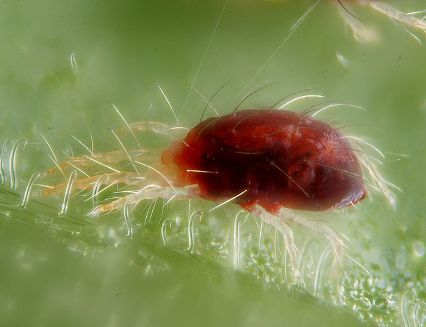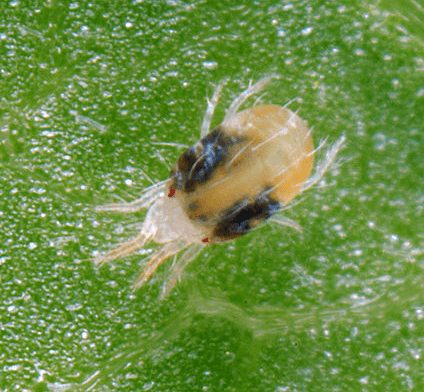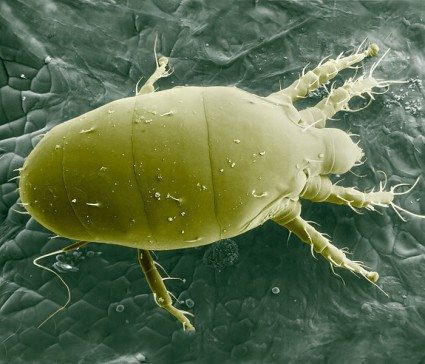Do you have them? They’re a particularly annoying form of vegetarians especially fond of indoor gardens. What are plant mites, how did they get in your grow room, and how do you get rid of them? Wait! Get rid of… as in completely? Read on, frustrated grower, you can win the battle with grow room mites.
The mite family is very large, with varied feeding habits ranging from your pillow’s dead skin particles to your dog’s ear wax, and so forth – right up to your favourite plants. We will address here the vegan side of the family and leave the others for your local pet shop to handle. Plant mites have been and always will be part of the garden culture, no gardener will be exempt from them in their lifetime, if you haven’t seen them yet, have patience, they are coming. Often diagnosed in one-size-fits-all general terms as being “spider mites” or “red mites”, we need to keep in mind there are thousands of different species within the Acari family, and it should not be excluded that multiple kinds live on the same plant, explaining why your “knock it all down” pesticide solutions doesn’t seem to ever solve the problem.

Red Spider Mite (Courtesy of Gilles San Martin)
The famous “spider mite” (Tetranichus Urticae) group bears its name pretty well, especially if you know that “Urticaire” is the french word for “hives” the extremely unpleasant skin rashes that are nearly impossible to prevent and treat. Mites are known to quickly adapt to changes, are a prolific annoyance that loves life almost everywhere it lands, feeding on over 1100 plant species. Pesticide resistance is certainly one of their great traits, patience is another one, as they can walk for days without eating while seeking brave new worlds to munch on. There are often just as many mites on your plants as there are on the walls of the grow room, and also outside the grow room, yes, this includes the bedroom where they love to watch you sleep 😉
Like many other insects they will easily over-winter hiding everywhere, and in almost everything, biding their time while waiting for warmer weather to return. Even Quebec winters aren’t cold enough to kill them. Sometimes growers infest their in-home garden simply by bringing heating wood inside, defrosting armies of starving new chlorophyl hunters that were quietly sleeping in the bark of their logs. They will hitch rides on anything, like your shoes and your pets. Keeping them at bay starts with always keeping everything clean. “Everything” includes the floors, the walls, the growing equipment, trays, tables, and your own self… Yes, mites love crawling on you, as far as they know you could be a giant moving tree, enjoy the itch. Not providing hiding spots, and using a rotation of preventive measures is part of the solution.
Mites, like most other pests are opportunistic, and designed to remove plants from growing conditions that are not favourable. (Thank you, Darwin…) Healthy plants, in optimal growing conditions are usually able to resist pests fairly well. Therefore the only realistic approach to fighting mites begins by not providing them with what they want: a hot and dry environment. The warmer and drier it gets, the faster they will take over. While the overall averages of your climate (growing conditions) may seem really fine, microclimates created by keeping lights too close to canopy (radiant heat), or having ventilation that’s too strong (desiccation) may just provide them with all the luxury they need. Until this is understood, we will always have annoyed growers running about claiming, “This doesn’t work!” after trying any control technique or products.
If you are looking for a “one shot – kill all” approach to rid yourself of this nuisance, there is really only one thing you can do… burn your garden down. Even by doing so, and restarting your garden in a pharmaceutically aseptic controlled environment, if you persist in giving them hot and dry, you can bet they will come back to haunt you down the line.
Let’s look at the “egg to adult that lays eggs” cycle:
- Around 20C and above 60% Humidity, this cycle can take up to 25 days.
- When offered “Club Med” conditions, like 30C and under 35% Humidity, this cycle can be as short as 5 days. The frosting on the cake? In those conditions egg production can jump from less than 5 per day to over 15.
It takes no mathematician to see the exponential disaster unfolding when those conditions are met.
Another sad reality that growers need to get over, is that if webs are seen, the battle is lost. Spider mites got their name from the webs they spin, but unlike true spiders, catching a fly is of no interest to them, remember they are vegan. Those webs are multi-purpose – providing protection, a communication network, but mainly transport routes for the young ones to leave the colony to establish themselves elsewhere. As the plant is not able to provide sufficient amount of food for the colonies, the mites instinctively begins to spin more and more of those super highways. In short, they know this plant isn’t going to do well any time soon, and at this point growers should accept the defeat, swiftly destroying the web-infested victim… before those millions of eggs hatch.
Nevertheless, it doesn’t matter how many big guys these little critters brought to tears, “spider mites” are actually the easy ones.

Two Spotted Mite (Courtesy of J. Halopainen)
Many mite varieties are invisible to the naked eye and highly capable of wrecking your production’s potential in a very short time. Some of those small varieties have a formidable asset, they are so small that most foliar sprays will not even reach them, making them almost immune to contact pesticides. Leaving only systemic alternatives to control them, unfortunately that means poisoning your plants, which down the line often means poisoning yourself too.
There are two kinds quickly rising in popularity in indoor gardens across the world – the Broad Mite, and the Hemp Russet Mite. Neither of them spin webs, making them harder to spot, their near invisibility proving a formidable weapon against gardeners who refuse to see the need of a microscope in their toolbox.
Broad Mite damage may be, at first, less obvious than it’s big Two Spotted cousins, the typical pale dot caused by their piercing apparels is way smaller. Damages often begins with slight discolouration of infested leaves, from pale green to light bronze, stunted growth, malformations, and other symptoms that are often mistaken to be nutrient deficiencies, or pH issues. You will need minimally a 60X microscope to see them and some dexterity, as they tend to move fast, and hide well. There are few effective treatment against them, some less than practical than others, but some growers do have success lowering infested plants in water held at 44C for 15 minutes. [Proceed at your own risk, higher temperatures will cook your plants too.]

Broad Mite (Courtesy of Brian0918)
Many growers throughout America have recently encountered the skinny Hemp Russet Mite (a.k.a. Tomato Russet Mite). Probably resurrected by the return of industrial help agriculture, they were not often seen a decade ago, but are now gaining lot’s of grounds all over the North American continent. Under proper magnification (15X or more), they look like tiny cylinders, that barely move. They are often found in tiny groups munching at the very tip of growing shoots, damaging the meristem, slowing growth down to a halt, inducing growth distortion that may sometimes look like early flower formation, except no flower material ever materializes, and the plants are dwarfed to death. Some growers have reported plants being stalled for weeks, twisting without growing before eventually dying. Being uneasy to see, growers tend to look in the wrong direction when seeking the cause of their dismay by throwing the blame on faulty growing mediums, nutrients, and really anything they can blame it on, like their co-workers…
The damage done by those invisible (not to say invincible) mites is often noticed too late on mother plants, further more expanding their invasive abilities to unsuspecting cutting buyers. Affected plants should be discarded, and the grow area thoroughly scrubbed, and kept super clean afterwards.
Realistically, there is no need for details on every plant-loving mite family out there. The key to avoid them laying a host of destructive creatures is providing proper climate, clean growing conditions, and religiously applying a rotation of preventive measures. Stop looking for a “one-hit kill-all” solution, unless you are really willing to burn things down.
Good luck and happy gardening,
Rick
Sources include:
http://www.nature.com/nature/journal/v479/n7374/full/nature10640.html
http://www.planetnatural.com/pest-problem-solver/houseplant-pests/russet-mite-control/
http://www.hightimes.com/read/grow-hack-beware-broad-mite
https://en.wikipedia.org/wiki/Mite